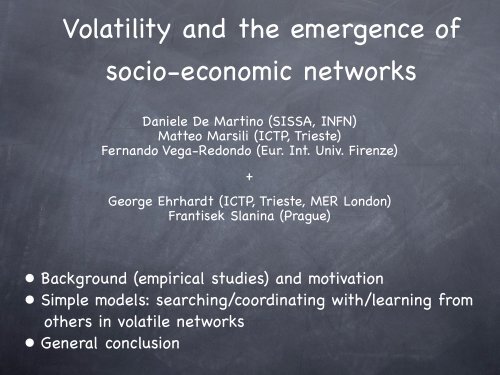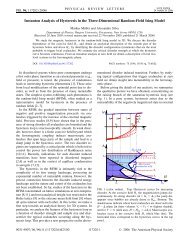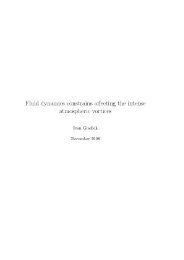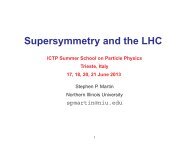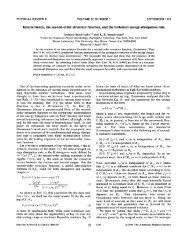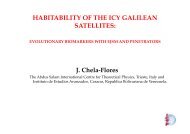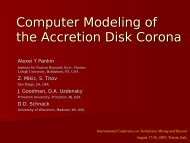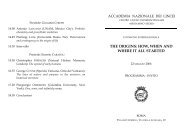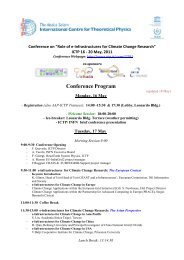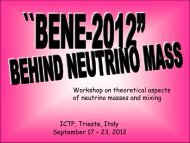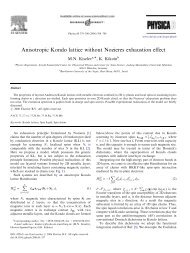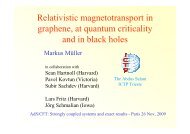The rise and fall of a networked society - ICTP
The rise and fall of a networked society - ICTP
The rise and fall of a networked society - ICTP
You also want an ePaper? Increase the reach of your titles
YUMPU automatically turns print PDFs into web optimized ePapers that Google loves.
Volatility <strong>and</strong> the emergence <strong>of</strong><br />
socio-economic networks<br />
Daniele De Martino (SISSA, INFN)<br />
Matteo Marsili (<strong>ICTP</strong>, Trieste)<br />
Fern<strong>and</strong>o Vega-Redondo (Eur. Int. Univ. Firenze)<br />
+<br />
George Ehrhardt (<strong>ICTP</strong>, Trieste, MER London)<br />
Frantisek Slanina (Prague)<br />
• Background (empirical studies) <strong>and</strong> motivation<br />
• Simple models: searching/coordinating with/learning from<br />
others in volatile networks<br />
• General conclusion
Collective social phenomena:<br />
anecdotical evidence<br />
Many bars in a central area <strong>of</strong> Trieste<br />
a crowd <strong>of</strong> hundreds teenagers forms every tuesday<br />
evening in front <strong>of</strong> bar Costa<br />
No crowd on different days <strong>and</strong> in different bars, no such<br />
effect two years ago<br />
How did such dense “social network” a<strong>rise</strong>?<br />
Why tuesday? Why bar Costa? How did they coordinate?
Networks everywhere<br />
• Labor markets (Granovetter, Topa, Calvó-A. & Jackson)<br />
• Crime/social pathologies (Crane, Glaeser et al, Harding)<br />
• R&D partnerships (Gulati et al, Hagerdoorn)<br />
• Scientific collaboration (Newman, Goyal et al)<br />
• Patterns <strong>of</strong> trade (Kranton & Minehart, Rauch, Greif)<br />
• Organizational performance (Radner, Garicano, Cabrales et al)<br />
• Industrial districts (Jacobs, Saxenian)
<strong>The</strong> <strong>rise</strong> <strong>of</strong> networks<br />
R&D partnerships, joint<br />
ventures (Hagendoorn)<br />
Scientific collaboration networks<br />
(Goyal, Newman)<br />
Web communities (del.icio.us)<br />
...
Networks → Economics<br />
Economic performance correlates with<br />
social capital (Putnam)<br />
Finding jobs (Granovetter, Topa, Calvó-<br />
A. & Jackson)<br />
Resilience <strong>of</strong> industrial districts<br />
(silicon valley vs route 128: Jacobs,<br />
Saxenian)<br />
Diffusion <strong>of</strong> ideas <strong>and</strong> technological<br />
progress (Diamond)
Chance <strong>and</strong> necessity<br />
Necessity: economic incentives<br />
Chance: environmental volatility<br />
(Monod)<br />
Both the links <strong>and</strong> the agents themselves change as a<br />
result <strong>of</strong> several (<strong>of</strong>ten unobservable) factors (e.g.<br />
partnership may turn unpr<strong>of</strong>itable)<br />
Opportunities <strong>of</strong> new connections are affected by factors<br />
beyond agents’ control (e.g. searching partners).<br />
→ <strong>The</strong> Red Queen effect: “It need all the running you can<br />
do to keep in the same place” (Carrol)<br />
Under what conditions do dense networks emerge?
Minimal models <strong>of</strong> volatile networks<br />
Links decay at a constant rate<br />
Links formation limited by<br />
- similar technological levels<br />
- similar opinions<br />
- coordination<br />
- reputation<br />
- search through friends<br />
Dense network promotes<br />
similarity/proximity/<br />
coordination/information<br />
diffusion/searchability/..<br />
e.g. R&D network<br />
network<br />
density<br />
technological<br />
growth<br />
technological<br />
heterogeneity
Node <strong>and</strong> link volatility<br />
Both links (relationships) <strong>and</strong> nodes (individuals)<br />
are not permanent in general<br />
Under what conditions do dense <strong>and</strong> efficient<br />
social networks emerge?<br />
How stable should the composition <strong>of</strong> a <strong>society</strong><br />
be to speak meaningfully <strong>of</strong> a social network?<br />
A simple model:<br />
Learning to coordinate in a volatile world<br />
(efficiency = coordination)
is this statistical physics?<br />
Topology<br />
↓<br />
Interaction + noise<br />
↓<br />
collective behavior<br />
(phase transitions,<br />
order/disorder, growth,<br />
synchronization, ...)
A stylized model <strong>of</strong> a <strong>society</strong>:<br />
• A <strong>society</strong> <strong>of</strong> N agents<br />
Each agent adopts one <strong>of</strong> q possible norms:<br />
s i =1,…,q<br />
• Norm revision<br />
At a rate ν each agent updates his norm to<br />
a r<strong>and</strong>om norm if isolated (experimentation)<br />
the norm <strong>of</strong> one his neighbors (e.g. voter)<br />
• Link formation<br />
At a rate η agent i meets an agent j drawn at<br />
r<strong>and</strong>om. If s i =s j they establish a link<br />
• Environment volatility<br />
1- A pr<strong>of</strong>itable cooperation may turn<br />
unpr<strong>of</strong>itable: each link decays at a rate 1<br />
2- Agent turnover:<br />
each node loses all links at rate α<br />
Agents Norms<br />
disorder – low link density<br />
order – high link density
<strong>The</strong> Master equation<br />
• Microscopic state<br />
– Network + norms: ω = {a i,j , s i },<br />
a i,j = 0 (no link i-j) or 1 (i-j linked)<br />
s i =1,…,q<br />
• Link creation<br />
ω ω’={ω −i,j , a i,j =1}, W[ω ω’]=2η(1-a i,j )/(N-1)<br />
• Link removal<br />
ω ω’={ω −i,j , a i,j =0}, W[ω ω’]=λa i,j<br />
• Norm revision<br />
ω ω’={ω −i , r i =r’}, W[ω ω’]=ν, r’ majority norm
• Let<br />
<strong>The</strong> stationary state I<br />
• All states in Ω = are ergodic, all states in Ω/Ω = are transient<br />
– Pro<strong>of</strong>:<br />
links between agents with different s are never created<br />
all states in Ω = can be reached passing from the empty network<br />
• <strong>The</strong> invariant measure is<br />
– Pro<strong>of</strong>: detailed balance
<strong>The</strong> stationary state II<br />
• <strong>The</strong> distribution <strong>of</strong> the fraction n s <strong>of</strong> agents with s i =s is given by<br />
• For N large, {n s } is a.s. given by the minima <strong>of</strong><br />
• <strong>The</strong> solution can be characterized by the number L + <strong>of</strong> n s =n + where n + (n - )<br />
is the largest (smallest) solution <strong>of</strong><br />
• <strong>The</strong> L + =0 solution exists <strong>and</strong> is a minimum for all z≤1<br />
L + >1 solutions are saddle points<br />
L + =1 solution is a minimum iif n + z<br />
n 0 =fraction <strong>of</strong> isolated nodes (k=0)
the “free-energy”<br />
f<br />
-2.4<br />
-2.6<br />
-2.8<br />
-3<br />
-3.2<br />
-3.4<br />
-3.6<br />
-3.8<br />
-4<br />
L=0 stable<br />
L=0 unstable<br />
L=1 stable<br />
L=1 unstable<br />
L=2 unstable<br />
L=3 unstable<br />
f(n) = 1<br />
2 2.5 3 3.5 4 4.5 5<br />
!<br />
η<br />
N<br />
log P {n}<br />
16
<strong>The</strong> dynamics (t finite, N∞)<br />
• Mean field dynamics<br />
• If n s n s * then<br />
lim<br />
t→∞ nk,s(t) =n ∗ s<br />
(zn ∗ s) k<br />
• <strong>The</strong> stationary states n s * are the same as those<br />
found above (min f stability)<br />
– Pro<strong>of</strong>: <strong>The</strong> Poisson transformation<br />
k!<br />
e −zn∗
Finite t <strong>and</strong> N: theory <strong>and</strong> simulations<br />
c = average degree<br />
time<br />
2η
Summary: if volatility affects links<br />
As a consequence <strong>of</strong> the feedback between<br />
networking efforts <strong>of</strong> individuals <strong>and</strong> the<br />
benefits the network provides in terms <strong>of</strong><br />
coordination, information <strong>and</strong> innovation<br />
diffusion, social cohesion, …<br />
Sharp transitions: socio-economic networks<br />
are expected to emerge in an abrupt<br />
manner<br />
Resilience: once dense networks form, they<br />
are robust to deterioration <strong>of</strong> external<br />
conditions<br />
Coexistence: for the same environmental<br />
parameters, the network can either be<br />
dense or very sparse, depending on the<br />
history<br />
What about node volatility (agents’ turnover)?
A stylized model <strong>of</strong> a <strong>society</strong>:<br />
• A <strong>society</strong> <strong>of</strong> N agents<br />
Each agent adopts one <strong>of</strong> q possible norms:<br />
s i =1,…,q<br />
• Norm revision<br />
At a rate ν each agent updates his norm to<br />
a r<strong>and</strong>om norm if isolated (experimentation)<br />
the norm <strong>of</strong> one his neighbors (e.g. voter)<br />
• Link formation<br />
At a rate η agent i meets an agent j drawn at<br />
r<strong>and</strong>om. If s i =s j they establish a link<br />
• Environment volatility<br />
1- A pr<strong>of</strong>itable cooperation may turn<br />
unpr<strong>of</strong>itable: each link decays at a rate 1<br />
2- Agent turnover:<br />
each node loses all links at rate α<br />
Agents Norms<br />
disorder – low link density<br />
order – high link density
• <strong>The</strong> symmetric solution:<br />
n0 = q<br />
η Gα (η/q)<br />
stable only if G (i.e. if )<br />
′ α (η/q) > 0 〈k〉 ↗η<br />
• <strong>The</strong> asymmetric solution α
20<br />
15<br />
10<br />
5<br />
Results <strong>and</strong> phase diagram<br />
a = 0<br />
a = 0.2<br />
0<br />
0 5 10 15<br />
!<br />
!<br />
100<br />
10<br />
q=10<br />
0 0.2 0.4 0.6 0.8 1 1.2<br />
As node volatility increases, it gets harder <strong>and</strong> harder to<br />
achieve coordination. For α>1 there is no coordination at all<br />
"<br />
23
m<br />
0.8<br />
0.6<br />
0.4<br />
0.2<br />
• Order parameter<br />
0<br />
Critical behavior<br />
0.2 0.4 0.6 0.8 1<br />
!<br />
m = x+ − x−<br />
η<br />
m ∼ | log(1 − α)| −1 .<br />
24
Similar effect in other models<br />
• E.g. searching partners on the network<br />
in a volatile world<br />
30<br />
"%&%!'!#<br />
25<br />
20<br />
15<br />
10<br />
5<br />
#%&%!%%!'!#%%!'#<br />
MM, F. Slanina, F. Vega-Redondo, PNAS 2004<br />
0<br />
! " #! #" $!<br />
!
Summary:<br />
Links formation is enhanced by coordination,<br />
similarity or proximity<br />
Link volatility: Links decay when no more useful<br />
(i.e. at a constant rate)<br />
→ Discontinuous<br />
phase transitions<br />
+ coexistence,<br />
hysteresis/resilience<br />
Link density<br />
Networking effort<br />
when node volatility (agents’ turnover)<br />
dominates, the transition becomes continuous <strong>and</strong><br />
no system wide coordination takes place
References:<br />
De Martino D, Marsili M,<br />
preprint http://arxiv.org/abs/0807.0348 (to appear in EPJB)<br />
Ehrhardt GCMA, Marsili M, Vega-Redondo F<br />
Phenomenological models <strong>of</strong> socioeconomic network dynamics<br />
PHYSICAL REVIEW E 74, 036106 (2006)<br />
Ehrhardt G, Marsili M, Vega-Redondo F<br />
Diffusion <strong>and</strong> growth in an evolving network<br />
INT. J. OF GAME THEORY 34, 383-397 (2006)<br />
Vega-Redondo F, Marsili M, Slanina F<br />
Clustering, cooperation, <strong>and</strong> search in social networks<br />
J. EUROPEAN ECONOMIC ASSOCIATION 3, 628-638 (2005)<br />
Marsili M, Vega-Redondo F, Slanina F<br />
<strong>The</strong> <strong>rise</strong> <strong>and</strong> <strong>fall</strong> <strong>of</strong> a <strong>networked</strong> <strong>society</strong>: A formal model<br />
P.N.A.S. 101, 1439-1442 (2004)
• Generic class <strong>of</strong> models<br />
- easier to establish interaction<br />
with similar/close agents<br />
- linked agents become more<br />
similar/closer<br />
↓<br />
sharp transition, coexistence,<br />
hysteresis if agents’ turnover is<br />
weak<br />
• Empirical evidence?<br />
Rise <strong>of</strong> networks <strong>and</strong> type <strong>of</strong><br />
volatility<br />
• Spatial models?<br />
Summary<br />
Link density c<br />
G. Ehrhardt, M. Marsili (<strong>ICTP</strong> Trieste)<br />
F. Slanina (Czech Acad. Sci. Prague)<br />
F. Vega-Redondo (Alicante)<br />
D. De Martino (SISSA)<br />
Link formation rate<br />
References:<br />
MM, FS, FVR, PNAS 2004<br />
GE, MM, FVR PRE 2006, IJGT 2006<br />
DD, MM, EPJB 2008
Knowledge/technology level<br />
• linked agents tend to become similar<br />
hi(t) → hi(t + ⎧<br />
⎨ maxj∈Ni<br />
) =<br />
⎩<br />
hj(t) techology adoption<br />
<br />
j∈Ni hj(t) knowledge diffusion<br />
• interaction is easier between similar nodes/agents<br />
• Link formation at rate 1 if |h i -h j | < δh<br />
• Volatility λ<br />
1<br />
|Ni|<br />
η otherwise<br />
hi(t)<br />
i j i j<br />
i j i j
Technology adoption:<br />
• Spread <strong>of</strong> h i ↓ c<br />
→ link formation rate ↑ c<br />
• Phase with slow growth,<br />
sparse network <strong>and</strong> large<br />
fluctuations <strong>of</strong> h<br />
• Phase with fast growth,<br />
dense network <strong>and</strong> small<br />
fluctuations <strong>of</strong> h<br />
• Sharp transition,<br />
coexistence <strong>and</strong><br />
hysteresis<br />
η/λ<br />
h i ~ v t


